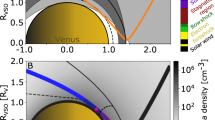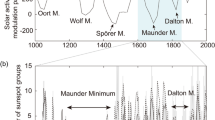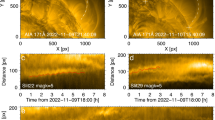Abstract
Supergranules, which are solar flow features with a lateral scale of 30,000–40,000 km and a lifetime of ~24 h, form a prominent component of the Sun’s convective spectrum. However, their internal flows, which can be probed only by helioseismology, are not well understood. We analyse dopplergrams recorded by the Solar Dynamics Observatory satellite to identify and characterize ~23,000 supergranules. We find that the vertical flows peak at a depth of ~10,000 km, and remain invariant over the full range of lateral supergranular scales, contrary to numerical predictions. We also infer that, within the local seismic resolution (≳5,000 km), downflows are ~40% weaker than upflows, indicating an apparent mass-flux imbalance. This may imply that the descending flows also comprise plumes, which maintain the mass balance but are simply too small to be detected by seismic waves. These results challenge the widely used mixing-length description of solar convection.
This is a preview of subscription content, access via your institution
Access options
Access Nature and 54 other Nature Portfolio journals
Get Nature+, our best-value online-access subscription
27,99 € / 30 days
cancel any time
Subscribe to this journal
Receive 12 digital issues and online access to articles
118,99 € per year
only 9,92 € per issue
Buy this article
- Purchase on SpringerLink
- Instant access to full article PDF
Prices may be subject to local taxes which are calculated during checkout



Similar content being viewed by others
Data availability
The HMI data are courtesy of NASA/SDO and the HMI Science Team. The HMI data are available from the Joint Science Operations Center export site http://jsoc.stanford.edu/. Due to the large volume of data, the mode-coupling products and kernels are available from the authors upon request. The numerical simulations are available upon request from M. Rempel.
Code availability
The mode coupling and inversion codes are available at https://github.com/cshanson/modeCoupling.git. Codes for the Slepian functions are available upon request from F. J. Simons.
References
Miesch, M. S. Large-scale dynamics of the convection zone and tachocline. Living Rev. Sol. Phys. 2, 1 (2005).
Fan, Y. Magnetic fields in the solar convection zone. Living Rev. Sol. Phys. 6, 4 (2009).
Nordlund, Å, Stein, R. F. & Asplund, M. Solar surface convection. Living Rev. Sol. Phys. 6, 2 (2009).
Hanasoge, S. M., Duvall, T. L. & Sreenivasan, K. R. Anomalously weak solar convection. Proc. Natl Acad. Sci. USA 109, 11928–11932 (2012).
Hanasoge, S., Gizon, L. & Sreenivasan, K. R. Seismic sounding of convection in the Sun. Annu. Rev. Fluid Mech. 48, 191–217 (2016).
Hart, A. B. Motions in the Sun at the photospheric level. IV. The equatorial rotation and possible velocity fields in the photosphere. Mon. Not. R. Astron. Soc. 114, 17–38 (1954).
Rincon, F. & Rieutord, M. The Sun’s supergranulation. Living Rev. Sol. Phys. 15, 6 (2018).
Rincon, F., Roudier, T., Schekochihin, A. A. & Rieutord, M. Supergranulation and multiscale flows in the solar photosphere. Global observations vs. a theory of anisotropic turbulent convection. Astron. Astrophys. 599, A69 (2017).
Simon, G. W. & Leighton, R. B. Velocity fields in the solar atmosphere. III. Large-scale motions, the chromospheric network, and magnetic fields. Astrophys. J. 140, 1120–1147 (1964).
Hirzberger, J., Gizon, L., Solanki, S. K. & Duvall, T. L. Structure and evolution of supergranulation from local helioseismology. Sol. Phys. 251, 417–437 (2008).
Parfinenko, L. D., Efremov, V. I. & Solov’ev, A. A. Supergranulation velocity field from the MDI (SOHO) data. Geomagn. Aeron. 54, 1026–1031 (2014).
Beck, J. G. A comparison of differential rotation measurements. Sol. Phys. 191, 47–70 (2000).
Langfellner, J., Gizon, L. & Birch, A. C. Spatially resolved vertical vorticity in solar supergranulation using helioseismology and local correlation tracking. Astron. Astrophys. 581, A67 (2015).
Featherstone, N. A. & Hindman, B. W. The emergence of solar supergranulation as a natural consequence of rotationally constrained interior convection. Astrophys. J. Lett. 830, L15 (2016).
Greer, B. J., Hindman, B. W. & Toomre, J. Helioseismic measurements of the Rossby number in the Sun’s near-surface shear layer. Astrophys. J. 824, 4 (2016).
Meunier, N., Tkaczuk, R., Roudier, T. & Rieutord, M. Velocities and divergences as a function of supergranule size. Astron. Astrophys. 461, 1141–1147 (2007).
Goldbaum, N., Rast, M. P., Ermolli, I., Sands, J. S. & Berrilli, F. The intensity profile of the solar supergranulation. Astrophys. J. 707, 67–73 (2009).
Langfellner, J., Birch, A. C. & Gizon, L. Intensity contrast of the average supergranule. Astron. Astrophys. 596, A66 (2016).
Wedemeyer-Böhm, S. & Rouppe van der Voort, L. On the continuum intensity distribution of the solar photosphere. Astron. Astrophys. 503, 225–239 (2009).
Gizon, L., Duvall, T. L. & Schou, J. Wave-like properties of solar supergranulation. Nature 421, 43–44 (2003).
Schou, J. Wavelike properties of solar supergranulation detected in Doppler shift data. Astrophys. J. Lett. 596, L259–L262 (2003).
Langfellner, J., Birch, A. C. & Gizon, L. Evolution and wave-like properties of the average solar supergranule. Astron. Astrophys. 617, A97 (2018).
Meunier, N. & Lagrange, A. M. Unexpectedly strong effect of supergranulation on the detectability of Earth twins orbiting Sun-like stars with radial velocities. Astron. Astrophys. 625, L6 (2019).
Meunier, N. & Lagrange, A. M. The effects of granulation and supergranulation on Earth-mass planet detectability in the habitable zone around F6-K4 stars. Astron. Astrophys. 642, A157 (2020).
Leighton, R. B., Noyes, R. W. & Simon, G. W. Velocity fields in the solar atmosphere. I. Preliminary report. Astrophys. J. 135, 474 (1962).
Prandtl, L. Bericht über Untersuchungen zur ausgebildeten Turbulenz. Z. Angew. Math. Mech. 5, 136–139 (1925).
Böhm-Vitense, E. Über die Wasserstoffkonvektionszone in Sternen verschiedener Effektivtemperaturen und Leuchtkräfte. Mit 5 Textabbildungen. Zeitschrift Astrophys. 46, 108 (1958).
Lord, J. W., Cameron, R. H., Rast, M. P., Rempel, M. & Roudier, T. The role of subsurface flows in solar surface convection: modeling the spectrum of supergranular and larger scale flows. Astrophys. J. 793, 24 (2014).
Spruit, H. C. Convection in stellar envelopes: a changing paradigm. Mem. Soc. Astron. Ital. 68, 397–413 (1997).
Cossette, J.-F. & Rast, M. P. Supergranulation as the largest buoyantly driven convective scale of the Sun. Astrophys. J. Lett. 829, L17 (2016).
Simon, G. W. et al. On the relation between photospheric flow fields and the magnetic field distribution on the solar surface. Astrophys. J. 327, 964 (1988).
Stein, R. F. Solar surface magneto-convection. Living Rev. Sol. Phys. 9, 4 (2012).
Gizon, L. & Birch, A. C. Local helioseismology. Living Rev. Sol. Phys. 2, 6 (2005).
Goldreich, P. & Keeley, D. A. Solar seismology. I. The stability of the solar p-modes. Astrophys. J. 211, 934–942 (1977).
Duvall Jr, T. L., Jefferies, S. M., Harvey, J. W., Osaki, Y. & Pomerantz, M. A. Asymmetries of solar oscillation line profiles. Astrophys. J. 410, 829–836 (1993).
Duvall Jr, T. L. in Structure and Dynamics of the Interior of the Sun and Sun-like Stars SOHO 6/GONG 98 (ed. Korzennik, S.) 581–585 (ESA, 1998).
Zhao, J. & Kosovichev, A. G. in Local and Global Helioseismology: the Present and Future SOHO 12/GONG+ (ed. Sawaya-Lacoste, H.) 417–420 (ESA, 2003).
Sekii, T. et al. Initial helioseismic observations by Hinode/SOT. Publ. Astron. Soc. Jpn 59, S637 (2007).
Duvall, T. L. & Hanasoge, S. M. Subsurface supergranular vertical flows as measured using large distance separations in time–distance helioseismology. Sol. Phys. 287, 71–83 (2013).
Duvall, T. L., Hanasoge, S. M. & Chakraborty, S. Additional evidence supporting a model of shallow, high-speed supergranulation. Sol. Phys. 289, 3421–3433 (2014).
Korda, D. & Švanda, M. Plasma flows and sound-speed perturbations in the average supergranule. Astron. Astrophys. 646, A184 (2021).
Woodard, M. F. The seismic correlation signature of moderate-scale flow in the Sun. Astrophys. J. 649, 1140–1154 (2006).
Woodard, M. F. Probing supergranular flow in the solar interior. Astrophys. J. 668, 1189–1195 (2007).
Hill, F. Rings and trumpets—three-dimensional power spectra of solar oscillations. Astrophys. J. 333, 996–1013 (1988).
Greer, B. J., Hindman, B. W. & Toomre, J. Helioseismic imaging of supergranulation throughout the Sun’s near-surface shear layer. Astrophys. J. 824, 128 (2016).
Scherrer, P. H. et al. The helioseismic and magnetic imager (HMI) investigation for the Solar Dynamics Observatory (SDO). Sol. Phys. 275, 207–227 (2012).
Schou, J. et al. Design and ground calibration of the helioseismic and magnetic imager (HMI) instrument on the Solar Dynamics Observatory (SDO). Sol. Phys. 275, 229–259 (2012).
Gizon, L. et al. Helioseismology of sunspots: a case study of NOAA region 9787. Space Sci. Rev. 144, 249–273 (2009).
Moradi, H. et al. Modeling the subsurface structure of sunspots. Sol. Phys. 267, 1–62 (2010).
Snodgrass, H. B. Separation of large-scale photospheric Doppler patterns. Sol. Phys. 94, 13–31 (1984).
Hanson, C. S., Hanasoge, S. & Sreenivasan, K. R. Analyzing supergranular power spectra using helioseismic normal-mode coupling. Astrophys. J. 910, 156 (2021).
Hanasoge, S. & Mandal, K. Detection of Rossby waves in the Sun using normal-mode coupling. Astrophys. J. Lett. 871, L32 (2019).
Hanson, C. S., Hanasoge, S. & Sreenivasan, K. R. Discovery of high-frequency retrograde vorticity waves in the Sun. Nat. Astron. 6, 708–714 (2022).
Mani, P., Hanson, C. S. & Hanasoge, S. Imaging the Sun’s near-surface flows using mode-coupling analysis. Astrophys. J. 926, 127 (2022).
Woodard, M. F. Evidence for large-scale subsurface convection in the Sun. Mon. Not. R. Astron. Soc. 460, 3292–3297 (2016).
DeGrave, K., Jackiewicz, J. & Rempel, M. Validating time–distance helioseismology with realistic quiet-Sun simulations. Astrophys. J. 788, 127 (2014).
Fisher, G. H. & Welsch, B. T. in Subsurface and Atmospheric Influences on Solar Activity Vol. 383 (eds Howe, R. et al.) 373–380 (ASP, 2008).
Simons, F. J. & Wang, D. V. Spatiospectral concentration in the Cartesian plane. GEM - Int. J. Geomath. 2, 1–36 (2011).
Christensen-Dalsgaard, J. et al. The current state of solar modeling. Science 272, 1286–1292 (1996).
Rosenthal, C. S., Christensen-Dalsgaard, J., Nordlund, Å, Stein, R. F. & Trampedach, R. Convective contributions to the frequencies of solar oscillations. Astron. Astrophys. 351, 689–700 (1999).
Van der Walt, S. et al. scikit-image: image processing in Python. PeerJ 2, e453 (2014).
Brandenburg, A. Stellar mixing length theory with entropy rain. Astrophys. J. 832, 6 (2016).
Anders, E. H., Lecoanet, D. & Brown, B. P. Entropy rain: dilution and compression of thermals in stratified domains. Astrophys. J. 884, 65 (2019).
Hanasoge, S. M. & Cally, P. S. Multiple scattering of waves by a pair of gravitationally stratified flux tubes. Astrophys. J. 697, 651–659 (2009).
Hanson, C. S. & Cally, P. S. An analytical approach to scattering between two thin magnetic flux tubes in a stratified atmosphere. Astrophys. J. 781, 125 (2014).
Hanson, C. S. & Cally, P. S. The scattering of f- and p-modes from ensembles of thin magnetic flux tubes: an analytical approach. Astrophys. J. 791, 129 (2014).
Felipe, T., Braun, D., Crouch, A. & Birch, A. Scattering of the f-mode by small magnetic flux elements from observations and numerical simulations. Astrophys. J. 757, 148 (2012).
Deane, A. E., Knobloch, E. & Toomre, J. Traveling waves in large-aspect-ratio thermosolutal convection. Phys. Rev. A 37, 1817–1820 (1988).
Krishnamurti, R. & Howard, L. N. Large-scale flow generation in turbulent convection. Proc. Natl Acad. Sci. USA 78, 1981–1985 (1981).
Das, S. B. Recipe for inferring subsurface solar magnetism via local mode coupling using Slepian basis functions. Astrophys. J. 940, 92 (2022).
November, L. J. & Simon, G. W. Precise proper-motion measurement of solar granulation. Astrophys. J. 333, 427 (1988).
Duvall Jr, T. L., Jefferies, S. M., Harvey, J. W. & Pomerantz, M. A. Time–distance helioseismology. Nature 362, 430–432 (1993).
Woodard, M. Detectability of large-scale solar subsurface flows. Sol. Phys. 289, 1085–1100 (2014).
Anderson, E. R., Duvall Jr, T. L. & Jefferies, S. M. Modeling of solar oscillation power spectra. Astrophys. J. 364, 699–705 (1990).
Basu, S., Antia, H. M. & Tripathy, S. C. Ring diagram analysis of near-surface flows in the Sun. Astrophys. J. 512, 458–470 (1999).
Lavely, E. M. & Ritzwoller, M. H. The effect of global-scale, steady-state convection and elastic-gravitational asphericities on helioseismic oscillations. Philos. Trans. R. Soc. A 339, 431–496 (1992).
Hanasoge, S. M., Woodard, M., Antia, H. M., Gizon, L. & Sreenivasan, K. R. Sensitivity of helioseismic measurements of normal-mode coupling to flows and sound-speed perturbations. Mon. Not. R. Astron. Soc. 470, 1404–1420 (2017).
Townsend, R. H. D. & Teitler, S. A. GYRE: an open-source stellar oscillation code based on a new Magnus multiple shooting scheme. Mon. Not. R. Astron. Soc. 435, 3406–3418 (2013).
Townsend, R. H. D., Goldstein, J. & Zweibel, E. G. Angular momentum transport by heat-driven g-modes in slowly pulsating B stars. Mon. Not. R. Astron. Soc. 475, 879–893 (2018).
Goldstein, J. & Townsend, R. H. D. The contour method: a new approach to finding modes of nonadiabatic stellar pulsations. Astrophys. J. 899, 116 (2020).
Ferret, R. Z. SDO/HMI observations of the average supergranule are not compatible with separable flow models. Astron. Astrophys. 623, A98 (2019).
Hansen, P. C. Analysis of discrete ill-posed problems by means of the L-curve. SIAM Rev. 34, 561–580 (1992).
Duvall Jr, T. L. & Birch, A. C. The vertical component of the supergranular motion. Astrophys. J. Lett. 725, L47–L51 (2010).
Vögler, A. et al. Simulations of magneto-convection in the solar photosphere. Equations, methods, and results of the MURaM code. Astron. Astrophys. 429, 335–351 (2005).
Lord, J. W. Deep Convection, Magnetism and Solar Supergranulation. PhD thesis, Univ. of Colorado (2014).
Ball, W. H. & Gizon, L. A new correction of stellar oscillation frequencies for near-surface effects. Astron. Astrophys. 568, A123 (2014).
Švanda, M. Issues with time–distance inversions for supergranular flows. Astron. Astrophys. 575, A122 (2015).
Birch, A. C., Kosovichev, A. G. & Duvall Jr, T. L. Sensitivity of acoustic wave travel times to sound-speed perturbations in the solar interior. Astrophys. J. 608, 580–600 (2004).
Gizon, L. et al. Computational helioseismology in the frequency ___domain: acoustic waves in axisymmetric solar models with flows. Astron. Astrophys. 600, A35 (2017).
Acknowledgements
We thank F. J. Simons for the codes for computing Slepian functions, M. Rempel and R. Cameron for their insights into solar convection, J. W. Lord for the numerical simulations and J. Naranjo for his help with the NYUAD NetDRMS system. This research was carried out with the High Performance Computing resources at NYUAD. The datasets were prepared in the data centre at the Center for Space Science of NYUAD. This research is based upon work supported by Tamkeen under the NYUAD Research Institute (Grant Nos G1502 and CASS to C.S.H, S.H. and K.R.S.). S.H. acknowledges funding from the Department of Atomic Energy, India. K.R.S. and S.H. acknowledge support from the Office of Sponsored Research of King Abdullah University of Science and Technology (Award No. OSR-CRG2020-4342). S.B.D. acknowledges funding from the Elisabeth H. and F. A. Dahlen Award 2022 by the Department of Geosciences, Princeton University. S.B.D. also acknowledges funding from the European Union’s Horizon 2020 research and innovation programme under a Marie Skłodowska-Curie grant (Grant Agreement No. 101034413). Some data products were processed and downloaded from the German Data Center for SDO, which is funded by the German Aerospace Center (DLR Grant No. 500L1701).
Author information
Authors and Affiliations
Contributions
C.S.H., S.H. and K.R.S. designed the research. C.S.H. developed the software and performed the observational and computational analysis. S.B.D. developed and implemented the mathematical formalism for Slepian functions in this analysis. P.M. tuned the surface measurements and developed the software. All authors discussed the results and contributed to the manuscript.
Corresponding author
Ethics declarations
Competing interests
The authors declare no competing interests.
Peer review
Peer review information
Nature Astronomy thanks Michal Švanda and the other, anonymous, reviewer(s) for their contribution to the peer review of this work.
Additional information
Publisher’s note Springer Nature remains neutral with regard to jurisdictional claims in published maps and institutional affiliations.
Supplementary information
Supplementary Information
Supplementary Figs. 1–15 and Table 1.
Rights and permissions
Springer Nature or its licensor (e.g. a society or other partner) holds exclusive rights to this article under a publishing agreement with the author(s) or other rightsholder(s); author self-archiving of the accepted manuscript version of this article is solely governed by the terms of such publishing agreement and applicable law.
About this article
Cite this article
Hanson, C.S., Bharati Das, S., Mani, P. et al. Supergranular-scale solar convection not explained by mixing-length theory. Nat Astron 8, 1088–1101 (2024). https://doi.org/10.1038/s41550-024-02304-w
Received:
Accepted:
Published:
Issue Date:
DOI: https://doi.org/10.1038/s41550-024-02304-w



